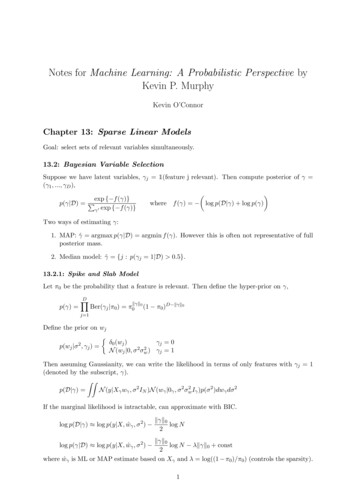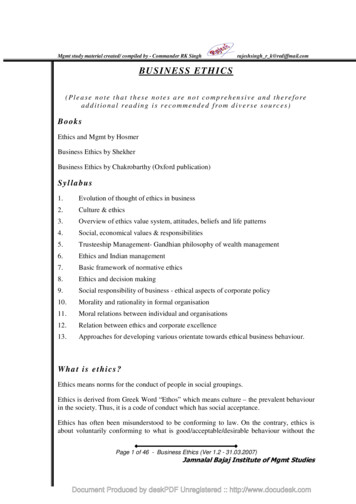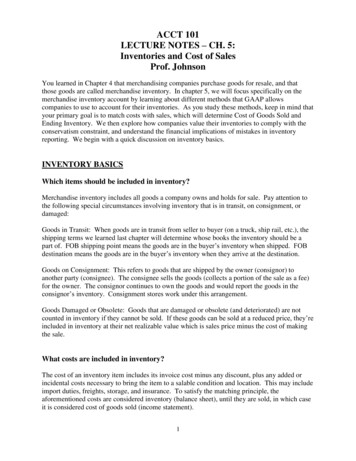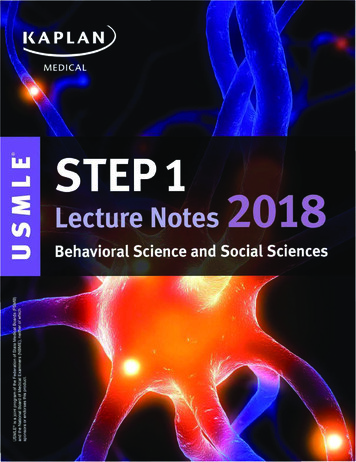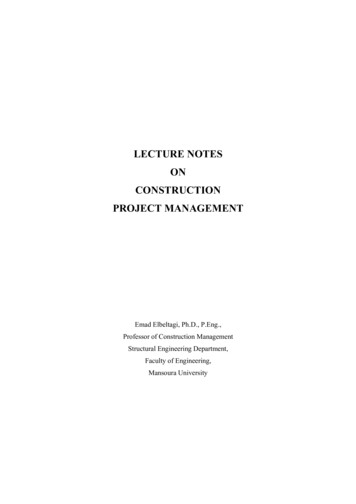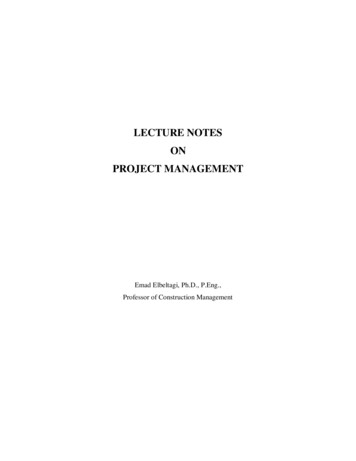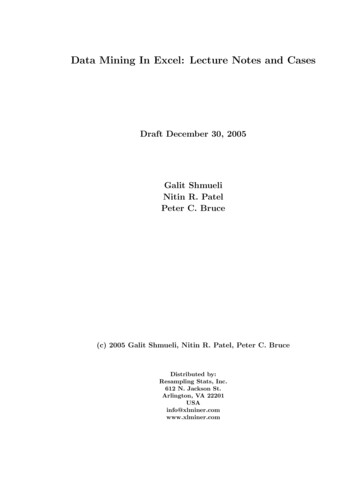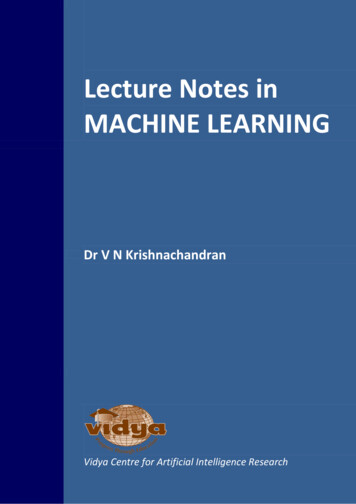
Transcription
Lecture Notes inMACHINE LEARNINGDr V N KrishnachandranVidya Centre for Artificial Intelligence Research
This page is intentionally left blank.
L ECTURE N OTES INM ACHINE L EARNINGDr V N KrishnachandranVidya Centre for Artificial Intelligence ResearchVidya Academy of Science & TechnologyThrissur - 680501
Copyright 2018 V. N. KrishnachandranPublished byVidya Centre for Artificial Intelligence ResearchVidya Academy of Science & TechnologyThrissur - 680501, Kerala, IndiaThe book was typeset by the author using the LATEX document preparation system.Cover design: AuthorLicensed under the Creative Commons Attribution 4.0 International (CC BY 4.0) License. You maynot use this file except in compliance with the License. You may obtain a copy of the License ce: Rs 0.00.First printing: July 2018
PrefaceThe book is exactly what its title claims it to be: lecture notes; nothing more, nothing less!A reader looking for elaborate descriptive expositions of the concepts and tools of machinelearning will be disappointed with this book. There are plenty of books out there in the marketwith different styles of exposition. Some of them give a lot of emphasis on the mathematical theorybehind the algorithms. In some others the emphasis is on the verbal descriptions of algorithmsavoiding the use of mathematical notations and concepts to the maximum extent possible. There isone book the author of which is so afraid of introducing mathematical symbols that he introducesσ as “the Greek letter sigma similar to a b turned sideways". But among these books, the author ofthese Notes could not spot a book that would give complete worked out examples illustrating thevarious algorithms. These notes are expected to fill this gap.The focus of this book is on giving a quick and fast introduction to the basic concepts and important algorithms in machine learning. In nearly all cases, whenever a new concept is introducedit has been illustrated with “toy examples” and also with examples from real life situations. In thecase of algorithms, wherever possible, the working of the algorithm has been illustrated with concrete numerical examples. In some cases, the full algorithm may contain heavy use of mathematicalnotations and concepts. Practitioners of machine learning sometimes treat such algorithms as “blackbox algorithms”. Student readers of this book may skip these details on a first reading.The book is written primarily for the students pursuing the B Tech programme in ComputerScience and Engineering of the APJ Abdul Kalam Technological University. The Curriculum forthe programme offers a course on machine learning as an elective course in the Seventh Semesterwith code and name “CS 467 Machine Learning”. The selection of topics in the book was guidedby the contents of the syllabus for the course. The book will also be useful to faculty members whoteach the course.Though the syllabus for CS 467 Machine Learning is reasonably well structured and covers mostof the basic concepts of machine learning, there is some lack of clarity on the depth to which thevarious topics are to be covered. This ambiguity has been compounded by the lack of any mentionof a single textbook for the course and unfortunately the books cited as references treat machinelearning at varying levels. The guiding principle the author has adopted in the selection of materialsin the preparation of these notes is that, at the end of the course, the student must acquire enoughunderstanding about the methodologies and concepts underlying the various topics mentioned in thesyllabus.Any study of machine learning algorithms without studying their implementations in softwarepackages is definitely incomplete. There are implementations of these algorithms available in theR and Python programming languages. Two or three lines of code may be sufficient to implementan algorithm. Since the syllabus for CS 467 Machine Learning does not mandate the study of suchimplementations, this aspect of machine learning has not been included in this book. The studentsare well advised to refer to any good book or the resources available in the internet to acquire aworking knowledge of these implementations.Evidently, there are no original material in this book. The readers can see shadows of everythingpresented here in other sources which include the reference books listed in the syllabus of the coursereferred to earlier, other books on machine learning, published research/review papers and alsoseveral open sources accessible through the internet. However, care has been taken to present thematerial borrowed from other sources in a format digestible to the targeted audience. There areiii
ivmore than a hundred figures in the book. Nearly all of them were drawn using the TikZ package forLATEX. A few of the figures were created using the R programming language. A small number offigures are reproductions of images available in various websites. There surely will be many errors– conceptual, technical and printing – in these notes. The readers are earnestly requested to pointout such errors to the author so that an error free book can be brought up in the future.The author wishes to put on record his thankfulness to Vidya Centre for Artificial IntelligenceResearch (V-CAIR) for agreeing to be the publisher of this book. V-CAIR is a research centre functioning in Vidya Academy of Science & Technology, Thrissur, Kerala, established as part of the“AI and Deep Learning: Skilling and Research” project launched by Royal Academy of Engineering, UK, in collaboration with University College, London, Brunel University, London and BennettUniversity, India.VAST CampusJuly 2018Dr V N KrishnachandranDepartment of Computer ApplicationsVidya Academy of Science & Technology, Thrissur - 680501(email: krishnachandran.vn@vidyaacademy.ac.in)
SyllabusCourse codeCS467Course NameMachine LearningL - T - P - Credits3-0-0-3Year of introduction2016Course Objectives To introduce the prominent methods for machine learning To study the basics of supervised and unsupervised learning To study the basics of connectionist and other architecturesSyllabusIntroduction to Machine Learning, Learning in Artificial Neural Networks, Decision trees, HMM,SVM, and other Supervised and Unsupervised learning methods.Expected OutcomeThe students will be able toi) differentiate various learning approaches, and to interpret the concepts of supervised learningii) compare the different dimensionality reduction techniquesiii) apply theoretical foundations of decision trees to identify best split and Bayesian classifierto label data pointsiv) illustrate the working of classifier models like SVM, Neural Networks and identify classifiermodel for typical machine learning applicationsv) identify the state sequence and evaluate a sequence emission probability from a given HMMvi) illustrate and apply clustering algorithms and identify its applicability in real life problemsReferences1. Christopher M. Bishop, Pattern Recognition and Machine Learning, Springer, 2006.2. Ethem Alpayidin, Introduction to Machine Learning (Adaptive Computation and machineLearning), MIT Press, 2004.3. Margaret H. Dunham, Data Mining: Introductory and Advanced Topics, Pearson, 2006.v
vi4. Mitchell T., Machine Learning, McGraw Hill.5. Ryszard S. Michalski, Jaime G. Carbonell, and Tom M. Mitchell, Machine Learning : AnArtificial Intelligence Approach, Tioga Publishing Company.Course PlanModule I. Introduction to Machine Learning, Examples of Machine Learning applications Learning associations, Classification, Regression, Unsupervised Learning, Reinforcement Learning. Supervised learning- Input representation, Hypothesis class, Versionspace, Vapnik-Chervonenkis (VC) DimensionHours: 6. Semester exam marks: 15%Module II. Probably Approximately Learning (PAC), Noise, Learning Multiple classes, ModelSelection and Generalization, Dimensionality reduction- Subset selection, PrincipleComponent AnalysisHours: 8. Semester exam marks: 15%FIRST INTERNAL EXAMINATIONModule III. Classification- Cross validation and re-sampling methods- Kfold cross validation,Boot strapping, Measuring classifier performance- Precision, recall, ROC curves.Bayes Theorem, Bayesian classifier, Maximum Likelihood estimation, Density functions, RegressionHours: 8. Semester exam marks: 20%Module IV. Decision Trees- Entropy, Information Gain, Tree construction, ID3, Issues in DecisionTree learning- Avoiding Over-fitting, Reduced Error Pruning, The problem of MissingAttributes, Gain Ratio, Classification by Regression (CART), Neural Networks- ThePerceptron, Activation Functions, Training Feed Forward Network by Back Propagation.Hours: 6. Semester exam marks: 15%SECOND INTERNAL EXAMINATIONModule V. Kernel Machines - Support Vector Machine - Optimal Separating hyper plane, Softmargin hyperplane, Kernel trick, Kernel functions. Discrete Markov Processes, Hidden Markov models, Three basic problems of HMMs - Evaluation problem, findingstate sequence, Learning model parameters. Combining multiple learners, Ways toachieve diversity, Model combination schemes, Voting, Bagging, BootingHours: 8. Semester exam marks: 20%Module VI. Unsupervised Learning - Clustering Methods - K-means, Expect-ation-Maxi-mizationAlgorithm, Hierarchical Clustering Methods, Density based clusteringHours: 6. Semester exam marks: 15%END SEMESTER EXAMINATIONQuestion paper pattern1. There will be FOUR parts in the question paper: A, B, C, D.2. Part Aa) Total marks: 40b) TEN questions, each have 4 marks, covering all the SIX modules (THREE questionsfrom modules I & II; THREE questions from modules III & IV; FOUR questions frommodules V & VI).
viic) All the TEN questions have to be answered.3. Part Ba) Total marks: 18b) THREE questions, each having 9 marks. One question is from module I; one questionis from module II; one question uniformly covers modules I & II.c) Any TWO questions have to be answered.d) Each question can have maximum THREE subparts.4. Part Ca) Total marks: 18b) THREE questions, each having 9 marks. One question is from module III; one questionis from module IV; one question uniformly covers modules III & IV.c) Any TWO questions have to be answered.d) Each question can have maximum THREE subparts.5. Part Da) Total marks: 24b) THREE questions, each having 12 marks. One question is from module V; one questionis from module VI; one question uniformly covers modules V & VI.c) Any TWO questions have to be answered.d) Each question can have maximum THREE subparts.6. There will be AT LEAST 60% analytical/numerical questions in all possible combinations ofquestion choices.
ContentsIntroductioniiiSyllabus12vIntroduction to machine learning1.1Introduction . . . . . . . . . . . . . . . . . . .1.2How machines learn . . . . . . . . . . . . . .1.3Applications of machine learning . . . . . . .1.4Understanding data . . . . . . . . . . . . . . .1.5General classes of machine learning problems1.6Different types of learning . . . . . . . . . . .1.7Sample questions . . . . . . . . . . . . . . . .1. 1. 2. 3. 4. 6. 11. 13Some general concepts2.1Input representation . . . .2.2Hypothesis space . . . . .2.3Ordering of hypotheses . .2.4Version space . . . . . . .2.5Noise . . . . . . . . . . . .2.6Learning multiple classes .2.7Model selection . . . . . .2.8Generalisation . . . . . . .2.9Sample questions . . . . .151515181922222324253VC dimension and PAC learning273.1Vapnik-Chervonenkis dimension . . . . . . . . . . . . . . . . . . . . . . . . . . . . . 273.2Probably approximately correct learning . . . . . . . . . . . . . . . . . . . . . . . . . 313.3Sample questions . . . . . . . . . . . . . . . . . . . . . . . . . . . . . . . . . . . . . . 344Dimensionality reduction4.1Introduction . . . . . . . . . . . . . . . .4.2Why dimensionality reduction is useful .4.3Subset selection . . . . . . . . . . . . . .4.4Principal component analysis . . . . . .4.5Sample questions . . . . . . . . . . . . .5.353536363846Evaluation of classifiers5.1Methods of evaluation . . . . . . . . . . .5.2Cross-validation . . . . . . . . . . . . . . .5.3K-fold cross-validation . . . . . . . . . . .5.4Measuring error . . . . . . . . . . . . . . .5.5Receiver Operating Characteristic (ROC)5.6Sample questions . . . . . . . . . . . . . .48484949515458viii
CONTENTS6ixBayesian classifier and ML estimation6.1Conditional probability . . . . . . . . . . . . . . . .6.2Bayes’ theorem . . . . . . . . . . . . . . . . . . . .6.3Naive Bayes algorithm . . . . . . . . . . . . . . . .6.4Using numeric features with naive Bayes algorithm6.5Maximum likelihood estimation (ML estimation) .6.6Sample questions . . . . . . . . . . . . . . . . . . .61616264676870Regression7.1Definition . . . . . . . . . . . . . .7.2Criterion for minimisation of error7.3Simple linear regression . . . . . .7.4Polynomial regression . . . . . . .7.5Multiple linear regression . . . . .7.6Sample questions . . . . . . . . . .72727374777880Decision trees8.1Decision tree: Example . . . . .8.2Two types of decision trees . . .8.3Classification trees . . . . . . .8.4Feature selection measures . . .8.5Entropy . . . . . . . . . . . . . .8.6Information gain . . . . . . . . .8.7Gini indices . . . . . . . . . . .8.8Gain ratio . . . . . . . . . . . .8.9Decision tree algorithms . . . .8.10 The ID3 algorithm . . . . . . .8.11 Regression trees . . . . . . . . .8.12 CART algorithm . . . . . . . . .8.13 Other decision tree algorithms .8.14 Issues in decision tree learning8.15 Avoiding overfitting of data . .8.16 Problem of missing attributes .8.17 Sample questions . . . . . . . .83. 83. 84. 84. 89. 89. 92. 93. 94. 95. 96. 101. 105. 105. 106. 106. 107. 108Neural networks9.1Introduction . . . . . . . . . .9.2Biological motivation . . . . .9.3Artificial neurons . . . . . . .9.4Activation function . . . . . .9.5Perceptron . . . . . . . . . . .9.6Artificial neural networks . .9.7Characteristics of an ANN . .9.8Backpropagation . . . . . . .9.9Introduction to deep learning9.10 Sample questions . . . . . . .111. 111. 111. 112. 113. 116. 119. 119. 122. 129. 13110 Support vector machines10.1 An example . . . . . . . . . . . . . . . . . . . .10.2 Finite dimensional vector spaces . . . . . . . .10.3 Hyperplanes . . . . . . . . . . . . . . . . . . . .10.4 Two-class data sets . . . . . . . . . . . . . . . .10.5 Linearly separable data . . . . . . . . . . . . . .10.6 Maximal margin hyperplanes . . . . . . . . . .10.7 Mathematical formulation of the SVM problem.133. 133. 138. 141. 144. 144. 145. 147789.
CONTENTS10.810.910.1010.1110.1210.13xSolution of the SVM problem . .Soft margin hyperlanes . . . . . .Kernel functions . . . . . . . . . .The kernel method (kernel trick)Multiclass SVM’s . . . . . . . . .Sample questions . . . . . . . . . 149. 154. 155. 157. 158. 15911 Hidden Markov models11.1 Discrete Markov processes: Examples . . . .11.2 Discrete Markov processes: General case . .11.3 Hidden Markov models . . . . . . . . . . . . .11.4 Three basic problems of HMMs . . . . . . . .11.5 HMM application: Isolated word recognition11.6 Sample questions . . . . . . . . . . . . . . . .161. 161. 163. 167. 169. 170. 17112 Combining multiple learners12.1 Why combine many learners12.2 Ways to achieve diversity . .12.3 Model combination schemes12.4 Ensemble learning . . . . .12.5 Random forest . . . . . . .12.6 Sample questions . . . . . .173. 173. 173. 174. 176. 176. 17813 Clustering methods13.1 Clustering . . . . . . . . . . . . . . . . . . . . . . . .13.2 k-means clustering . . . . . . . . . . . . . . . . . . .13.3 Multi-modal distributions . . . . . . . . . . . . . . .13.4 Mixture of normal distributions . . . . . . . . . . . .13.5 Mixtures in terms of latent variables . . . . . . . . .13.6 Expectation-maximisation algorithm . . . . . . . . .13.7 The EM algorithm for Gaussian mixtures . . . . . .13.8 Hierarchical clustering . . . . . . . . . . . . . . . . .13.9 Measures of dissimilarity . . . . . . . . . . . . . . . .13.10 Algorithm for agglomerative hierarchical clustering13.11 Algorithm for divisive hierarchical clustering . . . .13.12 Density-based clustering . . . . . . . . . . . . . . . .13.13 Sample questions . . . . . . . . . . . . . . . . . . . .179. 179. 179. 186. 186. 188. 189. 190. 191. 194. 196. 200. 203. 204.Bibliography206Index207
List of s of learning process . . . . . . . . . . . . . . . . . . . . . . . . . . . . .Example for “examples” and “features” collected in a matrix format (data relatesto automobiles and their features) . . . . . . . . . . . . . . . . . . . . . . . . . . . .Graphical representation of data in Table 1.1. Solid dots represent data in “Pass”class and hollow dots data in “Fail” class. The class label of the square dot is to bedetermined. . . . . . . . . . . . . . . . . . . . . . . . . . . . . . . . . . . . . . . . .Supervised learning . . . . . . . . . . . . . . . . . . . . . . . . . . . . . . . . . . . .Data in Table 2.1 with hollow dots representing positive examples and solid dotsrepresenting negative examples . . . . . . . . . . . . . . . . . . . . . . . . . . . . .An example hypothesis defined by Eq. (2.5) . . . . . . . . . . . . . . . . . . . . . .Hypothesis h′ is more general than hypothes
CS467 Machine Learning 3 - 0 - 0 - 3 2016 Course Objectives To introduce the prominent methods for machine learning To study the basics of supervised and unsupervised learning To study the basics of connectionist and other architectures Syllabus Introduction to Machine Learning, Lea


